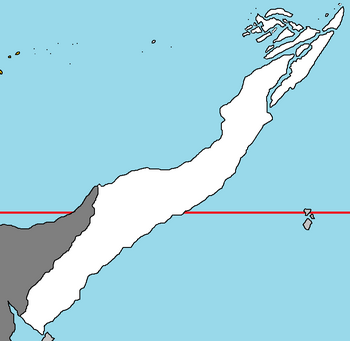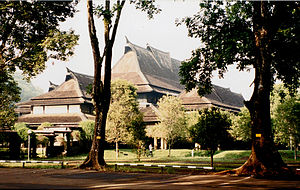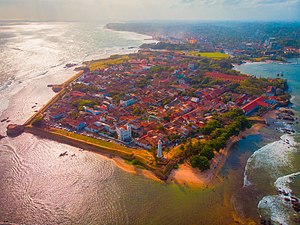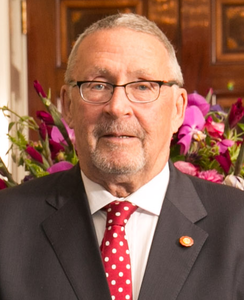Caruban
Caruban | |
|---|---|
| Motto: Aking karapatan, ating batas (My right, our law) | |
| Anthem: Diwa ng Bayan (Song of the Nation) | |
 | |
| Capital and largest city | Bonton |
| Official languages | Tagpalo, Caticeze-English |
| Demonym(s) | Carubanese |
| Government | Unitary semi-presidential republic |
• Lakan | Merob Wibowo |
• Prime Minister | William Langins |
| Legislature | Parliament L Batasan |
| Formation | |
• Republic of Strackenz | January 23, 1579 |
• Rumaztrian rule | September 1, 1708 |
• Self-Government Act | October 26, 1807 |
• Carubanese Parliament Act | February 22, 1826 |
• Independence Act | March 15, 1960 |
| Area | |
• Total | 153,696 km2 (59,342 sq mi) |
| Population | |
• 2010 census | 26,370,120 |
• Density | 171.5/km2 (444.2/sq mi) |
| GDP (PPP) | 2020 estimate |
• Total | $535.7 billion |
• Per capita | $20,314 |
| GDP (nominal) | 2020 estimate |
• Total | $435.7 billion |
• Per capita | $16,522 |
| HDI (2019) | very high |
| Currency | Carubanese dollar ($) |
| Date format | mm-dd-yyyy |
| Internet TLD | .cr |
Caruban (Tagpalo: ![]() , Cirebon), officially the Republic of Caruban, is a country in Ausiana. Vulkaria borders the country from the west, the Tervali Islands from the south, and the Samson Ocean from the east. A former Rumaztrian colony, much of its modern heritage is intertwined with central Ausianan culture. Its native residents, the Tagpalo people, share a long historical relationship with Vulkaria. Due to Rumaztria rule, the nation is bilingual and speaks Tagpalo and Caticeze-English. Pratoaboan, a Vulkarian language, is only recognized by various local governments, most of which are Tagpalo communities. The peninsular country is surrounded by the Samson Ocean. The capital and largest city in Caruban is Bonton.
, Cirebon), officially the Republic of Caruban, is a country in Ausiana. Vulkaria borders the country from the west, the Tervali Islands from the south, and the Samson Ocean from the east. A former Rumaztrian colony, much of its modern heritage is intertwined with central Ausianan culture. Its native residents, the Tagpalo people, share a long historical relationship with Vulkaria. Due to Rumaztria rule, the nation is bilingual and speaks Tagpalo and Caticeze-English. Pratoaboan, a Vulkarian language, is only recognized by various local governments, most of which are Tagpalo communities. The peninsular country is surrounded by the Samson Ocean. The capital and largest city in Caruban is Bonton.
The Tagpalo people arrived in the Caruban Peninsula in 900 BC. They settled in the Lusong archipelago, the group of islands north of the peninsula. Early Vulkarian states introduced the Tagpalo to a sedentary, agrarian lifestyle. In the 6th Century, the Tagpalo migrated to the mainland peninsula. The remaining tribes in the Lusong Islands maintained their sea-nomad traditions. In the mainland, the Tagpalo founded thalassocracies in large, stone-walled settlements. During the Warring City-States period (1500-1850), Vulkarian warlords conquered Caruban and formed the Republic of Strackenz. Pratoaboan-speaking Vulkarians colonized the peninsula and assimilated the mainlander Tagpalo. In 1708, the Rumaztrian Empire invaded Caruban to secure trade routes in the Samson Ocean. After the Zamastan War of Independence, Rumaztria enacted colonial reform to protect its colonial possessions. In Caruban, self-government was enacted in 1807 to prepare the territory's transition to an autonomous parliamentary democracy, finalized in the Carubanese Parliament Act of 1826. Clashes between Rumaztrian, Vulkarian, and Tagpalo politicians culminated into "Manifest Dominion," a racist system of minority representation where Rumaztrians dominated the Vulkarians and Tagpalo in influential aspects of society. Manifest Dominion ended in 1960 when the Rumaztrian parliament granted Caruban independence.
Caruban is a developed country with a high-income economy. The service industry is the top economic sector, followed by manufacturing as second and agriculture as third. Carubanese citizens enjoy a high quality of life, spanning from benefits in government transparency, free education up to high school, universal healthcare, and protections in civil liberties and economic freedom. The country is a republic with an elected, unicameral parliament. The prime minister, currently William Langins, is the head of government. A popularly elected Lakan, currently Merob Wibowo, is head of state. In its bid to institute permanent neutrality, Caruban renounced its right to declare war and abolished standing armed forces in the 1964 Constitution.
Etymology
The name Caruban traces its origin from an old legend. It usually varies, but the story always involves a Tagpalo merchant was visiting Vulkaria. When Vulkarians asked the merchant about their home country, they assumed the Vulkarians referred to their variety of wares, calling them "caruban."
"Caruban" (![]() ) is an old Tagpalo word for "mixed." Over the years, foreigners used other names like "Cheribon," "Chirebon," and "Sirivon." A Pratoaboan word Vulkarians used is "Karubon." Historically, Vulkarians used "Strackenz" for the peninsula, and it did become a name for a Vulkarian rump state in the 16th-19th centuries. "Strackenz" is now the name of a Carubanese province. In 1960, Cirebon (
) is an old Tagpalo word for "mixed." Over the years, foreigners used other names like "Cheribon," "Chirebon," and "Sirivon." A Pratoaboan word Vulkarians used is "Karubon." Historically, Vulkarians used "Strackenz" for the peninsula, and it did become a name for a Vulkarian rump state in the 16th-19th centuries. "Strackenz" is now the name of a Carubanese province. In 1960, Cirebon (![]() ) was adopted as the official native translation.
) was adopted as the official native translation.
At the beginning of Rumaztrian rule, when Caruban was still a loose confederation of indigenous tribes, Vulkarian cities, and Rumaztrian colonies, the colonial administration used the title "United Federation." The Self-Government Act in 1807 used the new title "Federation." In the 1964 Constitution, Caruban replaced the federal form of government with a unitary state, and the title "Federation" was replaced by "Republic."
History
Prehistoric to early history (Pre-1000 AD)
There has been human habitation in the Caruban Peninsula as long as 40,000 years ago. Sea nomads from Western Ausiana migrated to the peninsula in 900 BC. They settled in the Lusong Islands. Traders and settlers from Vulkaria arrived around the 1st Century AD, followed by Yuan in the 3rd Century AD. They established towns and ports along the southern coasts and introduced wet-rice farming (Yuan), pottery, and metallurgy (the latter two from Vulkaria). Their presence resulted in Vulkarian and Yuan influences in the local cultures. Increased trade in the mainland peninsula attracted migrants from the Lusong Islands.
A series of conquests erupted between the 7th and 9th Centuries, creating powerful, royal Tagpalo thassalocracies that dominated the peninsula. By the 10th Century, the Tagpalo kingdoms in the north and Vulkarian and Yuan city-states in the south divided the peninsula.
City-state era (1100-1850)
Living among Vulkarians, the peninsular Tagpalo assimilated into their culture and intermarried with each other. The Yuan settlers embraced Tagaplo culture, adapting local elements to their traditions and vice versa. Those in the northern parts of the peninsula and the Lusong Islands limited interactions with foreigners to trade. In the 1570s-1580s, at the height of the Warring City-States period, ambitious Vulkarian marcher lords took advantage of the growing chaos to expand their power. They looked north at the rich soil of Carubanese farmlands and united to lead a campaign to conquer the peninsula. The Conquest of Caruban (1579-1581) saw little resistance from the natives, especially from the early Vulkarian settlers. To deter suspicions from other Vulkarian warlords, the victorious conquerors hid their vast new estates behind the newly-founded Republic of Strackenz under the guise of protecting fellow Vulkarians living in the peninsula.
The Republic of Strackenz was a loose confederation of Tagpalo tribes dominated by Vulkarian city-states. A federal council or Bundesrat, elected by leaders of the peninsular states, governed Strackenz. Appointed representatives from all over the peninsula assembled in Hassenstadt to form Landtag, a legislature that met whenever the government needed to negotiate taxation and create new laws. In the rural areas, landed oligarchs called "Ranchkönige" (ranch kings) effectively ruled their large estates like independent states by controlling key provincial offices and had their private armies. Hassenstadt regularly clashed with the Ranchkönige to assert republican authority. Powerful, peninsular Tagpalo tribes competed with the Ranchkönige in dominance over lands and political positions.
In the early 18th Century, the Vulkarian city-states were still at war. The Kingdom of Rumaztria was interested in establishing a permanent presence in Eastern Ausiana to secure trade routes in the Samson Sea from Vulkarian pirates. In 1708, with the support of allied Vulkarian lords, Rumaztria moved expeditionary forces through Vulkaria and invaded Strackenz. The Rumaztrians renamed the territory to "Caruban."
In Rumaztria, a new era of massive demographic expansion began thanks to increases in agricultural production. Plans drawn for Rumaztria's outward expansion emphasized settler colonization. Between 1750-1800, over 100,000 people migrated to Caruban.
The events of the Zamastan War for Independence (1802-1804) made Rumaztria concerned with the stability and defense of its colonial empire. In an attempt to strengthen ties and the ability of Caruban to defend itself, Rumaztria granted Caruban self-government in 1807 to prepare the territory for full autonomy. In 1826, the Carubanese Parliament Act gave Caruban an independent, democratic legislature with the Rumaztrian king as head of state, governing on his behalf by a governor-general elected by parliament.
In the 19th Century, Caruban underwent an industrial revolution. The transition from an agricultural economy to an industrial economy attracted provincial residents to the cities. The Rumaztrian migrants comprised much of Caruban's growing merchant class, who led the more developed part of Carubanese society. The Vulkarian and Tagpalo Ranchkönige continued to rule the countryside until Carubanese Parliament passed the Agricultural Reform Act of 1848. It broke up large landholdings and redistributed them as smallholdings. Poorer Vulkarians and Tagpalo were freed from virtual serfdom. They received much of the redistributed land and, with it, granted them economic independence. In the long term, it encouraged intensive farming and allowed efficient use of the land.
Modern era (1850-present)
In the 1850s, disagreements between Caruban Parliament and the city-states over proposals of a unified military force. The Tagpalo city-state of Biringan led other city-states to rebellion in the Sovereignty War (1857-1859). The city-states were defeated. Parliament desposed their leaders and sent them to exile. The centuries-old federation finally ended.
In 1960, Rumaztrian parliament granted Caruban independence and ended Manifest Dominion. An interim parliament took over for four years to write a constitution. In 1964, the constitution of the new Carubanese republic was signed by King Caslav VI and Makisig Dungog, the first Lakan of Caruban.
Government and politics
Caruban is a parliamentary democracy with a semi-presidential executive modeled on the Quetanan system. Executive authority, or leadership of the government, is vested in a cabinet led by the head of state known as the Lakan. In the old days, the Lakan was an absolute ruler or paramount chieftain of the Tagpalo people. The modern Lakan enforces law, grants pardons, receive ambassadors, appoints cabinet officials and supreme court justices, and has reserve powers such as dissolving parliament and refusing to sign a bill into law. Under normal circumstances, the Lakan only exercises their powers on the advice of the Prime Minister and cabinet. For supreme court appointments, the Lakan takes advice from the Judicial Independence Commission.
The Carubanese Parliament is unicameral, legislates laws, and can remove the government through a vote of no confidence. Based on the rules of the Quetanan system, the 1964 Constitution enshrined the principles of parliamentary supremacy over the executive and judicial branches. Parliament democratically elects representatives every five years. Eligible formateurs in parliament, leaders of parties capable of winning an investiture vote, are nominated to become prime minister. After a general election or a vote of no confidence, the formateur of the winning party in an investiture vote will be appointed by the Lakan, as head of state, to form a government. Traditionally, the Lakan grants audiences to both the prime minister and the opposition leader to give minority parties a stronger voice in criticizing government policy. The cabinet, formed by the prime minister, is the highest policy-making body in the government and is collectively responsible for the consequences of their actions.
Elections are called by the Lakan either after every five years or after an investiture vote fails. The Lakan then dissolves parliament. Single-member districts called "pekan" (an old Tagpalo word for "market") are vacated upon dissolution and must nominate a candidate. A pekan candidate is usually elected by a local party from member residents. The candidate must win a simple plurality vote to represent local constituents as an MP or Member of Parliament.
The Batasan is the independent legislature for the Tagpalo people with devolved powers granted by the Carubanese Parliament. The Batasan's primary responsibility is to preserve Tagpalo cultural heritage. Unlike Carubanese Parliament, Batasan elects its members through party-list proportional representation. Winning parties are assigned seats based on the percentage of votes garnered by each party and the number of available seats (50). To qualify, parties must win at least 5% of the vote.
The Carubanese judicial system, headed by a chief justice, adjudicates on mixed common and civil law. The Supreme Court of Caruban is the highest court in the country. Court justices and officials are appointed non-politically under the strict rules implemented by the Judicial Independence Commission.
Lakan
6th Lakan of Caruban
8th Prime Minister of Caruban
The Lakan is the highest executive authority and most senior diplomat in the country. Nominally, they are the head of the cabinet and lead the executive branch. But in the adapted Quetanan system, constitutional convention dictates the Lakan, as head of state, to serve only as a ceremonial leader and to embody the representative traditions of national heritage, of everything that makes Caruban a unique country. His powers are exercised only at the advice of the government, the prime minister and cabinet. Exceptions to the rule only apply during emergency, when the government and parliament cannot function normally, and the Lakan may personally use emergency powers to maintain public order. Up until 1964, the Lakan was commander-in-chief of the armed forces (now abolished). The leadership of the country's civilian and paramilitary Carubanese Public Forces is vested in the Department of Interior.
As head of state, the Lakan has the following powers and responsibilities in the Constitution:
- Combined in themself the rights of sovereignty, the Lakan exercises them as chief of state so as long as they have the lawful consent of the people.
- The Lakan promulgates laws, treaties, and executive action necessary to enforce the law, but no executive action shall be made to alter existing law
- The Lakan calls elections, and convokes, prorogates, and dissolves parliament
- In times of crisis, when parliament cannot resume normal legislative duties, whether in peacetime or war, the Lakan assumes provisional legislative authority and issues executive action in the place of law. Such executive actions are valid statutes until a restored parliament decides otherwise.
- The Lakan appoints the prime minister, cabinet ministers, ambassadors, and other government officials as designated by law.
- The Lakan appoints supreme court justices as designated by the Judicial Independence Commission.
- The Lakan awards titles of nobility, rank, and other marks of honor as designated by the Batasan
- The Lakan grants amnesty and pardons, and commutations of punishment
Bonton, capital city
TEXT
Culture
National anthem
Diwa ng Bayan is the national anthem of Caruban. Josias Pertiwi wrote the composition in 1878. The Carubanese Parliament commissioned Pertiwi to compose a hymn for the 1879 State Opening of Parliament. Pertiwi adopted the lyrics from Fr. Genesis Lambosa's 1836 poem "O Sintang Lupa."
The Tagpalo version is not a direct translation of the Caticeze-English version.
| Official Caticeze-English version (Diwa ng Bayan) |
Official Tagpalo version (Diwa ng Bayan) |
Literal translation of the Tagpalo text |
|---|---|---|
Land of the morning, |
O sintang lupa, |
O beloved land, |






